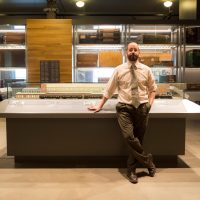
Steve Schwinghamer
Ph.D. Candidate
| Degrees: | BA (UofT), MA (SMU) |
| Email: | steveschwinghamer@cmail.carleton.ca |
Current Program:
Ph.D. History (2023)
Supervisors:
Prof. Laura Madokoro
Academic Interests:
Many! I’m a historian for the Canadian Museum of Immigration, so I have research projects that are aligned with the work of the institution, I have some personal projects, and I have a steady stream of engagement with public and professional inquiries about Canadian immigration that all come together to fill my days. First and foremost, though, I deal with the places and policies of Canadian immigration in the late 1800s and early 1900s. I’ve done lots of other interesting odds and ends across a broader timeline and encompassing public and oral history, too. For bite-size introductions to some of this, you could check my contributions for the Canadian Museum of Immigration at https://pier21.ca/taxonomy/term/34
Select Publications and Current Projects:
For my fellow velocipedists: https://niche-canada.org/2021/10/06/indexed-shifting-past-and-present-from-the-bike-saddle/ It’s bikes, it’s history, it’s the nature of memory in public space, and also fun! It’s one part of Claire Campbell’s wonderful Histoire en Vélo series for NiCHE & ActiveHistory; read one, read all, etc.
I’ve done a number of short, solicited publications, such as ’This is Ticklish Business’: Undesirable Religious Groups and Canadian Immigration After the Second World War”, Canadian Issues, Spring 2017. Ever wonder why the Canadian government thought willingness to use a tractor should be used to select immigrants? This one’s for you. https://pier21.ca/research/immigration-history/undesirable-religious-groups-and-canadian-immigration
The bulk of my more traditional scholarship has addressed the places of immigration in Halifax, Nova Scotia. My colleague Jan Raska and I wrote Pier 21: A History, which the University of Ottawa Press released in 2020. Some related articles: “Railroaded: A History of Halifax Immigration Facilities at Pier 2,” and “’Altogether Unsatisfactory’: Revisiting the Opening of the Immigration Facility at Halifax’s Pier 21.” I’ve also done an archaeological reconnaissance of the remains of the Lawlor’s Island quarantine facility; that’s on file with our friends at the Nova Scotia Museum, but you can see some photos of surviving resources at https://pier21.ca/blog/steve-schwinghamer/lawlors-island-results
I’ve had the good fortune to support some great projects at the museum, including the core exhibits on the history of Canadian immigration and of Pier 21 National Historic Site; a recent exhibit titled “Refuge Canada” which deals with Canada as a sanctuary (or not) through the twentieth century; and I curated a little exhibit on skating and Canadian immigration titled Perfect Landings, which Skate Canada – a partner on the content – liked enough to tour for a few years at their competitions.
My current projects include some work on queer exclusions in post- Second World War immigration policy, a look at expropriation and sites of immigration and immigration medical care, support for an upcoming museum temporary exhibit, and so on.
Select Conference Contributions:
Yes? Yes. I’ve presented at CHA a few times, at NCPH (including running an oral history workshop, which was great fun), and organized and presented at a bunch of other conferences. I do a fair few other kinds of presentations – public talks, media, and the like. Here’s a public talk about the history of Pier 21, if you’re curious: https://youtu.be/7-ccjh2lzUU?si=CPHAP-ffliUxAsXU.
Teaching Experience:
None in universities! (It’s weird. I should fix that, which is part of why I’m pursuing a doctorate.)
However, if you’re teaching immigration history, public history, or oral history, and are interested in connecting with the Canadian Museum of Immigration for resources / guest lectures / etc., hit me up. My colleagues and I do this all the time, and it’s one of my favourite parts of my work. :)
Description of Research:
In a nutshell, my doctoral research project explores the historical development of the Canadian immigration branch as a small network influenced by both domestic pressures and supranational solidarities of race, class, economics, and empire (1867–1950). The branch was central to the selective machinery that produced a “desirable” citizenry for the state, including by displacing Indigenous peoples and settling these preferred immigrants.